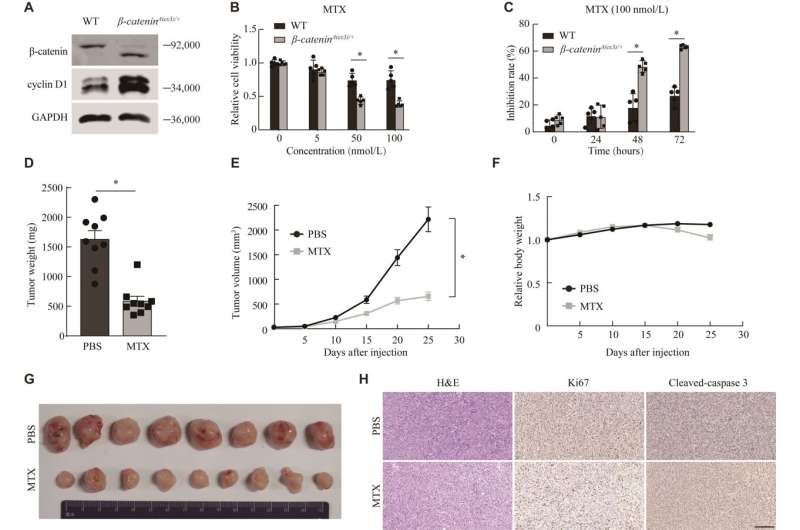This article has been reviewed according to Science X's editorial process and policies. Editors have highlighted the following attributes while ensuring the content's credibility:
fact-checked
proofread
Study reveals potential of methotrexate to treat liver cancer

Liver cancer is one of the most prevalent and deadly types of cancer worldwide. Most patients are diagnosed at an advanced stage, which leaves them with few treatment options. Unfortunately, the first-line drugs used in advanced hepatocellular carcinoma (HCC), the most common type of liver cancer, are not very effective and offer only modest clinical benefits.
Over the past few years, scientists have been trying to develop new therapies for HCC by analyzing specific genetic abnormalities and the ways in which they affect the manifestation and progression of the disease. One of the most common mutations in HCC occurs in CTNNB1 gene, which encodes a protein called β-catenin.
The mutated version of this protein is resistant to degradation, causing it to accumulate in the affected cells. Over time, excess β-catenin dysregulates the Wnt signaling pathway, which triggers uncontrolled cell proliferation. However, no therapies targeting β-catenin-related pathways have been approved yet.
Against this backdrop, a research team including Dr. Hongbing Zhang from the Chinese Academy of Medical Sciences and Peking Union Medical College in Beijing, China, has adopted a different approach. In their latest study, published in the Chinese Medical Journal, the researchers sought to determine whether existing chemotherapy drugs could be effective for treating β-catenin-activated liver cancer.
"Repurposing old drugs is an attractive strategy because it lowers overall drug development costs and shortens development timelines," states Dr. Zhang.
With this goal, the researchers first conducted a screening experiment using 12 widely used chemotherapeutic drugs. Employing both genetically modified cells in culture and mice inoculated with subcutaneous tumors expressing the mutated CTNNB1 gene, they found that methotrexate (MTX), a widely used drug for treating conditions such as psoriasis, rheumatoid arthritis, and certain types of cancer, was particularly effective against β-catenin-activated cells.
The efficacy and selectivity of MTX were further validated on β-catenin-activated human liver cancer cells in vitro and in vivo.
After that, the team investigated the underlying mechanisms that made MTX effective against β-catenin-activated cells. Interestingly, MTX does not directly affect β-catenin signaling. The analysis of the specific metabolic changes produced by this drug revealed that it represses β-catenin-boosted nucleotide synthesis that leads to malignancy.
"MTX, a folic acid antagonist, is an inhibitor of nucleotide metabolism. It blocks the conversion of dihydrofolate to tetrahydrofolate, thereby hindering nucleotide synthesis in proliferating cancer cells," explains Dr. Zhang. Further experiments showed that the dysregulated β-catenin-activated nucleotide synthesis itself sensitizes the mutant cells to MTX treatment in the first place.
HBV (hepatitis B virus)-induced chronic hepatitis is the major risk factor of HCC. To make the animal model experiments more clinically relevant, the researchers generated mice with HBV transgenic and β-catenin activation livers. After three months, mice treated with MTX had remarkably lower tumor incidence, smaller maximum tumor volumes, and minimal effects on body weights compared to untreated mice.
Taken together, the findings of this study hint at the potential of MTX as an alternative to current first-line treatments for liver cancer with a verified CTNNB1 mutation.
Satisfied with the results and with eyes on the future, Dr. Zhang concludes, "MTX is a promising chemotherapeutic agent for β-catenin-hyperactive liver cancer. Since repurposing MTX has the advantages of lower risk, shorter timelines, and less investment in drug discovery and development, a clinical trial is warranted to test its efficacy in the treatment of β-catenin mutant liver cancer."
More information: Fangming Liu et al, Oncogenic β-catenin-driven liver cancer is susceptible to methotrexate-mediated disruption of nucleotide synthesis, Chinese Medical Journal (2023). DOI: 10.1097/CM9.0000000000002816



















